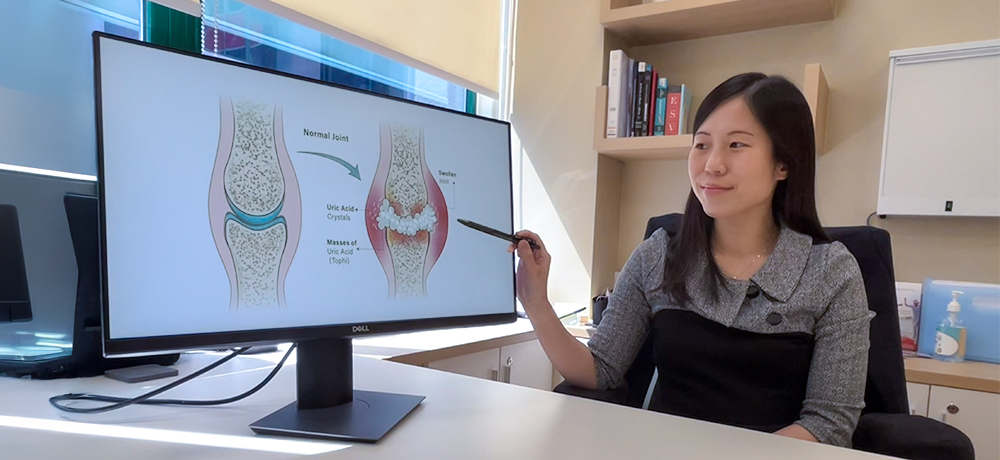The Truth About Gout: Insights from Rheumatologist, Dr Lydia
22 May 2025

Have you ever felt sudden, sharp pain and swelling in one of your joints?
You’re not alone. This condition, called gout, is quite common. It affects up to 4.35 million people in Southeast Asia, including Malaysia. But don’t be fooled — it is not entirely as harmless as you might think it is.
Dr Lydia Pok Say Lee, our Consultant Physician and Rheumatologist, shares important facts about this painful disease, debunks common myths, and explains why relying solely on painkillers to manage the symptoms is not enough.
.jpg)
What Is Gout?
Gout is a type of arthritis that causes episodes of joint swelling and pain, usually in the big toe. It is caused by uric acid crystals that form in the joint because of high levels of uric acid in the body.
Uric acid is made naturally in the body. Most of it leaves the body through urine. But in people with gout, the body cannot remove extra uric acid well, which leads to high levels of uric acid.
Common symptoms of gout include:
- Sudden, intense pain in the joint in the night or early morning
- Swelling, redness and warmth in the affected joint
Unlike other forms of arthritis, gout does not cause constant pain. Instead, the pain comes as sudden attacks. During an attack, the pain and swelling can be so severe that moving the affected joint may be nearly impossible.
Where Does Gout Usually Occur?
In the early stages, it usually only affects one joint. However, if left untreated over many years, it will affect multiple joints, including the knees, ankles, wrist and elbows.
It usually starts in the joints of the lower limbs, like the foot and ankle. As the condition progresses, it will spread upwards to affect the other joints.
What Are the Long-Term Effects If Gout Is Not Managed?
Most patients will only take over-the-counter painkillers during a gout attack.
However, according to Dr Lydia, this is the wrong approach. Doing so only treats the symptoms of gout and not the cause. Left untreated, it can lead to:
1. More Recurrent Attacks
During the initial stages, attacks will be far in between, occurring every few months. However, if the uric acid is not treated, the attacks will become more frequent. This can get to a point where it can feel like the swelling and pain is constant.
2. Joint Damage
Recurrent gout attacks can destroy the affected joint over time. Sometimes surgery may be needed to fix the damage.
3. Growth of Tophi
Tophi are deposits of uric acid crystals in the joint, which appears as a firm lump under the skin. This not only affects mobility of the joint, it can also cause the permanent destruction of the joint. Sometimes, the tophi lump can burst and get infected.
4. Kidney Damage
Taking painkillers or anti-inflammatory drugs a lot for gout attacks can hurt the kidneys over time. Uric acid can also build up in the kidneys and cause kidney stones.
What Are Common Triggers for Gout?
These foods are the main culprits behind gout flare-ups, as they raise uric acid levels in the body. Gout sufferers are recommended to avoid or limit eating these foods:
- Purine-Rich Foods: This includes foods such as red meats, alcohol, shellfish and organ meats.
- Foods Containing High Fructose Syrup: Highly processed sugary foods and drinks, such as soft drinks.
Sedentary living, as well as being obese, also puts you at a higher risk of gout.
Common Misconceptions About Gout
Many Malaysians still believe common myths about gout. Dr Lydia helps clear up a few of them below:
1. Gout is just a minor problem.
Gout is not just a minor inconvenience as most believe it to be. Left untreated, it can lead to serious long-term complications.
2. Gout is caused by diet alone.
While certain foods can trigger gout, only avoiding these foods is not enough to treat gout. Gout is often caused by kidneys being unable to excrete the excess uric acid. Long-term treatment is the most effective way to treat gout.
3. Gout only affects older people.
Gout isn't just for older adults. Younger people can get it too.
4. Taking long-term medications for gout will damage your kidneys in the long run.
This is untrue. Taking medications for gout can in fact have the opposite effect by protecting your kidneys in the long run. This is because it reduces your dependency on painkillers, which can be harmful to your kidneys.
Treatment Options for Gout
Dr Lydia advises that people with gout should see a specialist, not just depend on pain medicine bought over the counter.
With a proper check-up, a specialist can check if the joint pain is really gout and if they need long-term treatment,” she explains.
Long-term gout treatment often includes medicine to lower uric acid levels. It also means having regular blood tests to check those levels. This treatment helps lower the number of gout attacks and protects the joints from damage.
If you or someone you care about has joint pain and swelling, don’t ignore the symptoms. Seeing a gout specialist early can help prevent serious complications later on. To book a consultation with a Consultant Rheumatologist, click here.






